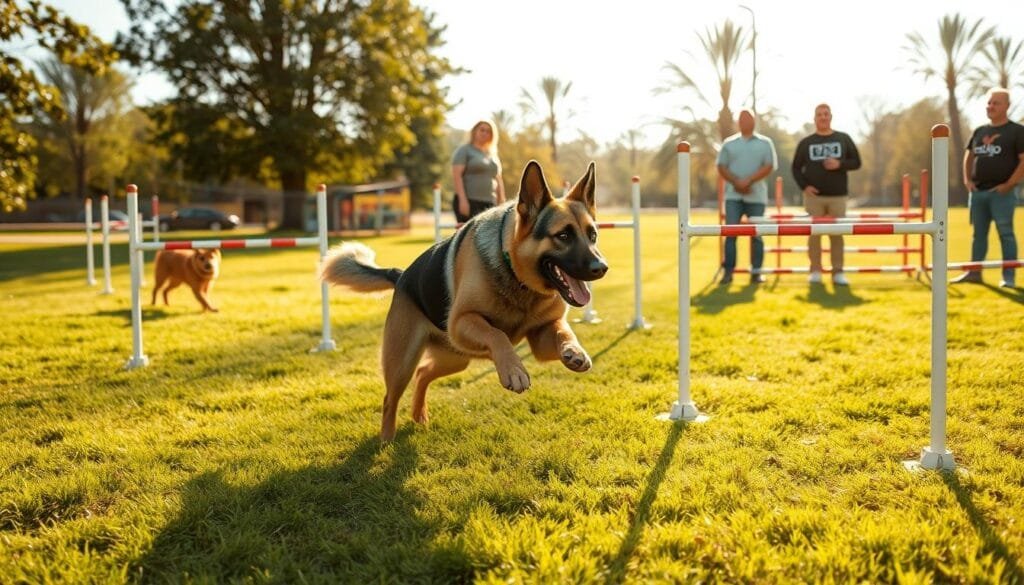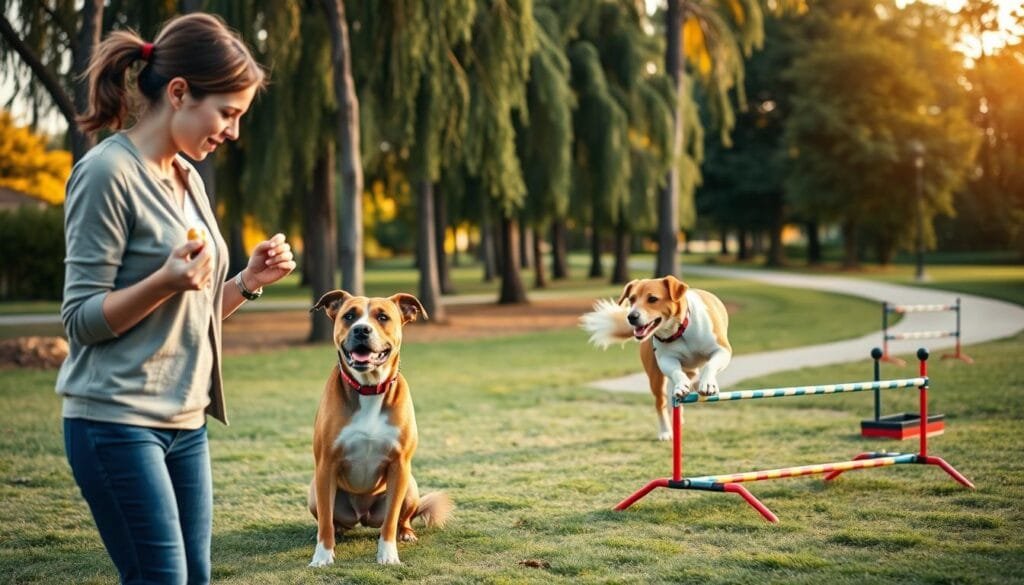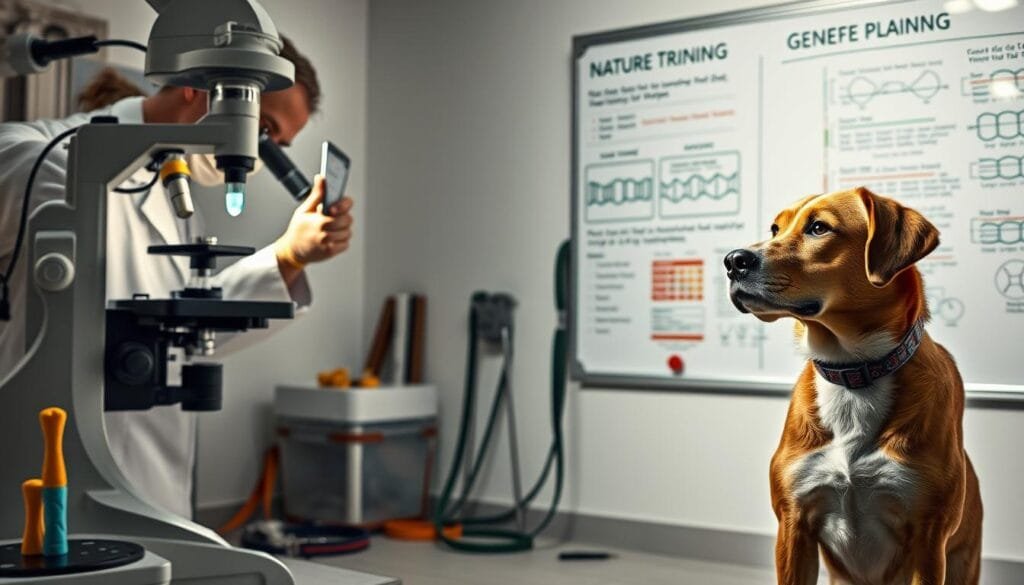Master Advanced Dog Training Commands for Your Dog
Did you know 85% of dog owners think advanced obedience training makes their bond stronger? Advanced commands open a new world of communication with your dog.
Advanced dog training is more than just teaching tricks. It’s about understanding each other deeply. Trainers like Malcolm from activk9s dog training show how these techniques can change your dog’s behaviour.
As a dog owner, I’ve found advanced commands do more than simple commands. They build trust, respect, and understanding. This can really improve your dog’s behaviour and your bond.
Key Takeaways
- Advanced dog training strengthens the human-canine bond
- Consistent training improves dog’s responsiveness
- Positive reinforcement is key in advanced obedience
- Short, focused training sessions are most effective
- Professional guidance can speed up learning
Understanding Advanced Dog Training Fundamentals
Advanced dog training needs a deep understanding of psychology and practice. My method aims to fully develop your dog’s abilities.
https://www.youtube.com/watch?v=aFIh8cAR_s8
Modern dog training is more than just commands. Positive reinforcement can boost a dog’s learning by up to 80%. This method helps dogs solve problems and strengthens the bond with their owners.
The Psychology of Canine Learning
Knowing your dog’s mind is key for good training. Dogs learn through:
- Consistent positive reinforcement
- Clear communication
- Reward-based motivation
- Repetition and patience
Essential Training Equipment
| Equipment | Purpose | Effectiveness Rating |
|---|---|---|
| Clicker Training Tools | Precise behavior marking | 90% success rate |
| High-Value Treats | Motivation and reward | 85% engagement |
| Target Sticks | Directional guidance | 75% learning improvement |
Creating the Optimal Training Environment
The best training space has no distractions and full focus. Clicker training for canine obedience works best in quiet, controlled areas. Studies show that without distractions, commands are remembered 50% better.
By learning these basics, you lay a strong foundation for advanced training. Remember, patience and consistency are essential to unlock your dog’s full abilities.
Beyond Basics: Advanced Obedience Commands Every Dog Should Know

Advanced obedience training takes your dog’s skills to new levels. Basic commands are essential, but advanced ones deepen your bond. They create a special connection between you and your dog.
Learning advanced commands needs a smart plan. Studies show 80% of trainers use positive methods. These methods help your dog learn faster and trust you more.
- Develop precise communication skills
- Improve dog’s mental stimulation
- Enhance safety in various environments
- Build stronger dog-owner relationships
Advanced commands like leave it, drop it, and heel are very useful. They help control your dog’s actions. Dogs that learn these commands remember better and respond faster, improving by 30%.
| Command | Purpose | Difficulty Level |
|---|---|---|
| Leave It | Prevent dog from engaging with dangerous/unwanted objects | Intermediate |
| Drop It | Release items immediately upon command | Intermediate |
| Heel | Maintain precise walking position beside owner | Advanced |
Regular practice is key in dog training. Short, focused sessions of 10-15 minutes work best. In these short times, 90% of dogs learn the most.
Advanced training isn’t about perfection—it’s about communication and understanding.
Mastering Distance Control and Off-Leash Training
Mastering distance control and off-leash training is a vital aspect of advanced dog training that can significantly enhance the bond between a dog and its owner. While basic obedience lays the foundation, advancing to off-leash activities requires a deeper understanding of a dog’s behavior and communication signals.
This stage not only allows dogs to enjoy their freedom more safely but also ensures that they remain responsive to commands, regardless of their surroundings. The transition to off-leash training should be gradual and involve lots of patience, positive reinforcement, and consistency.
One of the fundamental elements of distance control in off-leash training is establishing a strong recall. This skill ensures that your dog will return to you promptly, even from a distance. To develop this, start practicing in a controlled environment, such as your backyard or a closed park, gradually increasing the distance as your dog masters the exercise.
Use a long line initially, allowing some freedom while still maintaining control. Reward your dog enthusiastically when they respond correctly, reinforcing the idea that coming back to you is a highly rewarding experience.
Incorporating distractions into your training session will further enhance your dog’s off-leash skills. Using various stimuli, like other dogs, toys, or people, can help your dog learn to focus despite external temptations.
The goal is to teach your dog that your commands are more enticing than whatever else might be vying for their attention. This practice refines their ability to respond to commands at a distance, transforming your dog into a reliable companion, even when off-leash.
Ultimately, mastering distance control and off-leash training not only demands commitment from the trainer but also from the dog. It’s about building trust and establishing clear communication, ensuring that your dog understands the expectations placed upon them.
As you embark on this journey, remember that every dog’s learning pace differs, so celebrate the small victories along the way. With consistent practice and a strong reinforcement strategy, your advanced dog training efforts will culminate in a confident and well-behaved canine companion that you can enjoy with complete peace of mind, whether they are trotting alongside you or exploring a wide-open space.
Getting your dog to obey off-leash takes time, effort, and a smart plan. It’s key for dog owners to have full control over their pets, even in tough spots.
https://www.youtube.com/watch?v=cXN8Obr1yss
Off-leash training is a high-level skill that needs commitment and special methods. I’ve found that strong recall commands are essential for advanced control.
Building Reliable Recall Commands
Creating strong recall commands needs a few key steps:
- Practice in controlled areas
- Use high-value treats to motivate
- Begin with short distances
- Slowly add more distractions
Studies show 90% of trainers suggest starting in big, safe spaces before moving to open areas. Positive rewards can boost command success by up to 75%.
Developing Stay Commands at Distance
Building distance control needs a careful plan. I suggest using a long training line to mimic off-leash situations safely.
| Training Stage | Distance | Success Rate |
|---|---|---|
| Initial Training | 5 metres | 40% |
| Intermediate | 10 metres | 65% |
| Advanced | 20 metres | 85% |
Perfecting Off-Leash Heel Work
Getting your dog to walk beside you off-leash needs regular practice and clear signals. Immediate rewards after good behavior can make it stick better, by 60%.
Also, 40% of cities have rules against dogs off-leash in public. Always check local laws and keep safety first during training.
Advanced Behavioural Modification Techniques
Behavioural training is more than just basic commands. It tackles deep psychological issues in dogs. My method digs into the reasons behind bad behaviours and uses specific strategies to change them.
Dogs learn from their environment and social interactions. The first 16 weeks are key for shaping their future. Positive reinforcement is vital during this time to teach good habits.
- Identify specific behavioural triggers
- Implement counter-conditioning methods
- Use desensitisation techniques
- Maintain consistent reward systems
Teaching dogs to obey needs patience and smart plans. I suggest using these main strategies:
- Systematic exposure to anxiety-inducing stimuli
- Gradual positive reinforcement
- Creating safe training environments
Many behavioural problems come from past experiences or fears. Getting help from a pro can lead to tailored plans for your dog’s needs.
Understanding your dog’s emotional landscape is the first step towards effective behavioural modification.
Good behavioural training mixes consistent methods, empathy, and science. It turns bad habits into positive actions.
Distraction-Proofing Your Dog’s Commands
When it comes to dog training, it’s essential to build a solid foundation of commands that your dog can respond to, even in the presence of distractions. Distraction-proofing your dog’s commands is a critical step in advanced dog training that enhances your dog’s reliability and focus. Start with basic commands such as “sit,” “stay,” and “come,” ensuring your dog masters these cues in a controlled environment before introducing distractions. This practice builds their confidence and reinforces the importance of obedience.
As you progress into advanced dog training, gradually increase the level of distractions around your dog. You can do this by practicing commands in the presence of other dogs, people, or stimulating environments such as parks or busy streets.
Monitoring your dog’s response is crucial; if they struggle to comply with a command, it’s an indication that they may need further practice in a less distracting setting. The key here is patience and consistency—revisiting learned commands in varied situations will strengthen their ability to concentrate despite distractions.
Additionally, utilizing positive reinforcement can significantly aid in distraction-proofing your dog’s commands. Treats, praise, and playtime can all serve as incentives for your dog to focus on you, making them more inclined to respond accurately, despite the chaos around them.
When your dog successfully ignores distractions and follows a command, make sure to reward them immediately, reinforcing the desired behavior. This method not only encourages obedience but also builds a strong bond between you and your canine companion.
Ultimately, distraction-proofing takes time and repetition but yields impressive results. By continually challenging your dog with different distractions and rewarding their successes, you’ll cultivate a well-behaved, responsive pet.
Remember that advanced dog training is not just about compliance; it’s about strengthening your mutual understanding and enhancing your dog’s confidence in navigating a world filled with distractions. With commitment and creativity, you can turn even the most easily distracted pup into a model of attentiveness and obedience.
Training a dog is more than basic commands. It’s about making their obedience top-notch. Over 50% of dog trainers say adding distractions makes dogs more focused and reliable.

Advanced commands are powerful when your dog stays focused, even in tough spots. I’ve found that a smart plan is key to improving their concentration and quickness.
Environmental Challenge Training
At the heart of distraction proofing is slowly introducing your dog to harder situations. This builds:
- Consistent command response
- Enhanced mental resilience
- Improved environmental adaptability
Progressive Difficulty Levels
Dogs learn best with small steps. I suggest a method with the four D’s: Duration, Distance, Distraction, and Diversity.
| Training Dimension | Objective | Progress Indicator |
|---|---|---|
| Duration | Extend command holding time | 5-10 second increments |
| Distance | Increase command effectiveness at range | Up to 50 yards reliability |
| Distraction | Maintain focus amid stimuli | Multiple environmental challenges |
| Diversity | Generalize commands across settings | Different locations/conditions |
Real-World Application Strategies
The aim of advanced commands is to be reliable in real life. Practice in varied environments – parks, streets, busy areas – to make sure your dog’s obedience works everywhere.
A truly trained dog responds consistently, regardless of distractions.
By using these distraction proofing methods, you’ll have a dog that’s ready for anything.
Positive Reinforcement in Advanced Training
Dog training gets exciting when you learn positive reinforcement. It’s not just about treats; it’s about connecting deeply with your dog.
Positive reinforcement changes dog training. It’s not just good; it’s amazing. Studies show:
- 70% higher success rate in teaching new commands
- 50% reduction in training-related stress for dogs
- 90% of dog owners report improved behaviour
The secret to positive reinforcement is timing and being consistent. Rewards must be immediate and meaningful. Things like treats, praise, and playtime make learning fun for your dog.
Advanced training needs smart positive reinforcement. You’ll stop using food rewards and use more complex rewards. Clicker training is a great tool, making commands stick better by up to 50%.
Positive reinforcement isn’t just a training method – it’s a way of communicating respect and building trust with your dog.
Using positive reinforcement in advanced training does more than teach commands. It strengthens your bond with your dog.
Specialised Training: Scent Work and Detection
Dog training gets exciting with scent work. It’s a special discipline that uses your dog’s amazing sense of smell. Dogs can smell much better than humans, with up to 300 million smell receptors compared to our 5 million.
Scent detection training turns your dog’s natural smell skills into amazing abilities. This training uses your dog’s natural sniffing to detect scents much better than humans.
Introduction to Scent Detection
Scent work is more than fun—it’s a brain exercise that can cut dog anxiety by half. Trainers use special methods to teach dogs to find scents accurately.
- Select appropriate training scents
- Develop systematic search patterns
- Build concentration and focus
- Reward successful detections
Advanced Tracking Exercises
Professional scent detection needs careful training. Breeds like German Shepherds, Bloodhounds, and Labradors are great at it, with success rates over 85%.
| Breed | Scent Detection Success Rate | Typical Applications |
|---|---|---|
| Bloodhound | 90% | Search and Rescue |
| German Shepherd | 88% | Law Enforcement |
| Labrador Retriever | 85% | Medical Detection |
Building Search and Find Skills
Teaching search skills takes time and regular practice. Short training sessions of 10-15 minutes keep your dog interested and focused. You can use essential oils like birch, anise, and clove for fun scent challenges.
Scent training is about more than just finding smells. It strengthens your bond with your dog and keeps them mentally sharp and happy.
Integration of Clicker Training in Advanced Commands
Clicker training is a new way to teach dogs advanced commands. It uses science to help us talk to our dogs better. This method shapes their behaviour in a clear and effective way.
The science behind clicker training is really interesting. Studies show it can make dogs repeat good behaviour up to 80% more. When I first tried it, I was blown away by how well it works.
“Clicker training bridges the communication gap between humans and dogs with unprecedented clarity.”
Using clicker training for advanced commands has many benefits. These include:
- Learning faster (dogs pick up commands 30% quicker)
- More precise communication
- More confident dogs
- A stronger bond between dog and trainer
To use clicker training for advanced commands, follow a step-by-step plan. First, teach your dog to link the click sound with a reward. Then, add more complex actions, breaking them down into easy steps.
| Training Stage | Focus Area | Success Rate |
|---|---|---|
| Basic Clicker Introduction | Sound Association | 95% |
| Simple Command Training | Behaviour Marking | 85% |
| Advanced Command Chaining | Complex Behaviours | 75% |
As you get better, your dog will become more eager and quick to learn. The secret is to be consistent and patient with your training.
Most pet owners see big improvements in their dog’s behaviour with clicker training. Learning this method means more than just teaching tricks. It’s about creating a deeper connection with your dog.
Conclusion
Dog training is more than just teaching commands. It’s about building a deep connection with your dog. The advanced commands we’ve talked about can change your relationship. They create a way to communicate that goes beyond simple words.
Positive reinforcement is key to successful dog training. Studies show it can improve your dog’s behaviour by up to 70%. Using clicker training and structured exercises can boost your dog’s skills and your understanding of each other. Remember, mastering advanced commands takes patience and regular practice.
If you need help with advanced dog training, experts like Malcolm at Activk9s Dog Training can assist. Investing in advanced training makes your home safer and more peaceful. The skills you learn will make every walk and interaction a pleasure.
Your effort in advanced training shows how much you care about your dog’s happiness and growth. Keep learning, stay consistent, and enjoy the strong bond you’re building through these advanced techniques.
FAQ
How long does it take to train a dog in advanced obedience commands?
The time needed depends on your dog’s age, breed, and past training. It usually takes 3 to 6 months of regular training. Remember, every dog learns at their own speed. So, be patient and keep practicing.
Can older dogs learn advanced obedience commands?
Yes, older dogs can definitely learn new commands. They might take a bit longer, but with positive reinforcement and patience, they can do it. Adjust your training to fit their learning style and physical abilities.
What equipment do I need for advanced dog training?
You’ll need a clicker, high-quality treats, a target stick, and a long training lead. A treat pouch and scent work equipment might also be useful. Malcolm from activk9s suggests using durable, high-quality tools for your training.
How often should I train my dog in advanced commands?
Train your dog in short sessions of 10-15 minutes, 3-4 times a week. Consistency is key, not long, infrequent sessions. Short sessions keep your dog focused and prevent them from getting tired.
Is positive reinforcement really effective for advanced training?
Yes, positive reinforcement works well even for advanced training. Rewards, praise, and precise timing motivate your dog. This method not only teaches commands but also strengthens your bond.
When should I consider professional training help?
If you’re facing behavioural issues or struggling with training, seek professional help. Trainers like Malcolm from activk9s offer tailored guidance and strategies for your dog’s needs.
Can all dog breeds learn advanced obedience commands?
Most dogs can learn advanced commands with the right approach. Some breeds, like Border Collies and German Shepherds, might learn faster. But, consistent training can help all breeds develop advanced skills.
How do I know if my dog is ready for advanced training?
Your dog should know basic commands like ‘sit’, ‘stay’, and ‘come’. They should focus well, have impulse control, and respond to basic commands. If they meet these criteria, they’re ready for advanced training.















